Let's not meet by accident
March 7, 2021

Marione Martin
About 20 people gather for a safety seminar Saturday morning, Feb. 27, at the Alva Regional Airport. Capt. Matt Simpson provided information on how to avoid encounters with Vance Air Force Base aircraft.
Imagine enjoying a summer afternoon flight in a small private aircraft. The sun is shining. You can see for miles. Green fields and sparkling rivers pass below you.
Your eyes move from the scenery outside to check the instrument panel. You're steady on the planned heading, your altitude is correct and you're making good time to your destination. All is well.
As you raise your head, a much larger aircraft flashes past overhead at two or three times your speed. Your heart races as you process what you've just seen. You've just had a close encounter.
Vance Air Force Base in Enid conducts safety seminars for pilots to avoid collisions and near misses between military and civilian aircraft. On Saturday, Feb. 27, a morning seminar was held at the Alva Regional Airport. About 20 people attended with the majority of them being area aircraft pilots. Fog rolled in overnight, preventing the pilots from flying in to attend. Capt. Matt Simpson, a safety officer from Vance AFB, drove from Enid to present the program.
Simpson, who has been at Vance for over four years, was introduced by local pilot John Wiebener. After spending 21 years as an Air Force pilot, Wiebener retired and moved back to Alva about a year ago.
Types of Aircraft
Vance AFB trains nearly 450 pilots a year in three different high performance aircraft. This equates to over 395,000 aircraft movements in the surrounding airspace. In addition, Vance trains Air Force pilots from several foreign nations. Most student pilots have very little previous flying experience. The airfield is normally open from sunrise to sunset, Monday through Friday, some weeknights and Sunday afternoons at a reduced level.
Vance also trains many radar approach control and tower controllers on a continual basis concurrent with student pilot training.
Pilot training is done in the Beechcraft T-1A Jayhawk, the Raytheon-Beech T-6A Texan II and the Northrop T-38C Talon. Simpson said Vance had about 40 T-6 aircraft out on a cross country weekend when the polar freeze occurred in Oklahoma, and they couldn't make it back for a time. There are 95 T-6 aircraft in Vance's fleet.
Training Areas
Vance Air Force Base at Enid and Kegelman Auxiliary Field near Jet contain a high volume of traffic pattern operations from 500 to 3,000 feet above ground level.
Aircraft charts (maps) show various MOAs (military operations areas) where training is conducted. The MOAs contain high volumes of student formation, aerobatic, stall and spin training at all altitudes from 070 to 220 MSL (7,000 to 22,000 median sea level) and 080-230 MSL (80,000 to 230,000 MSL). Simpson pointed out these green and blue areas on the chart.
Other MOAs in red, orange, yellow, purple and light blue are low-level military training routes that contain high-speed single-ship and formation operations from 500 to 3,000 feet above ground level.
Using Local Airfields
Pilot training in the T-6 may be conducted at local non-towered airports. Simpson said the T-6 performs simulated engine-out, overhead, standard FAA patterns and instrument approaches at multiple locations. These include Alva, Cherokee, Anthony (KS), Medford, Blackwell, Wellington (KS), Ponca City, Perry, Guthrie and El Reno. When approaching one of these airfields, the pilot will announce their intentions on UNICOM/CTAF radio.

Marione Martin
Capt. Matt Simpson, safety officer from Vance AFB, describes the three types of aircraft flown in military training flights. during a seminar in Alva Feb. 27.
Student pilots also practice touch and goes at some of these airports including Alva. Simpson said a minimum runway length of 4,000 feet is needed for these exercises. In a touch and go, the pilot flies the standard runway approach pattern, the plane touches down on the runway, and the pilot then accelerates to take off again. For the no-engine emergency landing practice, a runway must be at least 3,000 feet long.
Communication is Key
Simpson provided information brochures about training at Vance. He repeatedly told pilots to talk to Vance Approach Control when planning to fly in the training areas. Approach control can provide traffic advisories. While it is not legally required, talking to Vance Approach Control gives the pilot the best chance of avoiding a collision. Using a transponder provides the tower with your location as an added safety measure.
When the Vance tower is not in operation, Kansas City Center can provide information.
For more information, contact the Vance Wing Safety Office at 580-213-7233 or Vance Airspace Management at 580-213-6276.
A video of the entire seminar may be seen at AlvaReviewCourier.com.















Reader Comments(0)